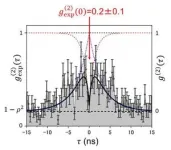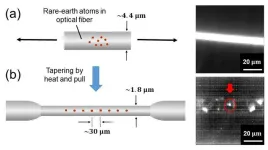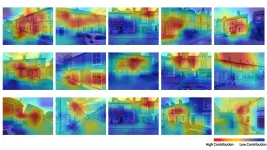(Press-News.org)
The discharge of organic effluents—biodegradable waste materials from plants and animals—into freshwater bodies is a significant environmental concern, affecting the health and sustainability of these aquatic ecosystems. However, the methods currently available for inspecting water quality are complex and costly.
In this regard, researchers from Ritsumeikan University, Japan, have recently developed a self-powered, inexpensive, and floating biosensor for monitoring water quality at the input of freshwater lakes and rivers. This paper was made available online on September 9, 2023, and was published in Volume 200 of the Biochemical Engineering Journal on November 1, 2023.
“We developed a self-powered, stand-alone, floating biosensor based on a microbial fuel cell (MFC) for early organic wastewater detection. The MFC case was fabricated by a 3D printer and the electrodes were fabricated from low-cost carbon-based materials,” remarks Professor Kozo Taguchi from the College of Science and Engineering, Department of Electrical and Electronic Engineering, Ritsumeikan University, who led the study.
MFCs generate electricity with the help of electrogenic bacteria. These microorganisms produce an electric current as a result of their biological metabolism. The amount of electricity generated by the MFC is proportional to the concentration of the organic waste that is being consumed by the electrogenic microorganisms. This characteristic feature is, thus, used to design organic waste biosensors powered by MFCs.
Using inexpensive carbon-based materials, the Japanese research team developed a self-powered biosensor based on a floating MFC (FMFC) to continually track the level of organic contamination in lakes and rivers. To this end, the team filled the anode (the electrode where oxidation occurs and electrons are given off) of the FMFC with soil containing electrogenic bacteria. The anodic bacteria subsequently decomposed the organic matter present in the water and converted the stored chemical energy into electricity. The electrical output was then used as a measure of the organic waste present in the contaminated water.
Although the researchers did not characterize the bacterial communities present in the soil sample, they rationally hypothesized that microorganisms from the genera Geobacter, Shewanella, and Pseudomonas contributed to the electrical activity. Prior studies indicate that paddy soils naturally contain electrogenic bacteria belonging to these genera.
Next, the team added a light-emitting diode (LED) to the floatable biosensor assembly. The LED was able to harness the electricity produced by the electrogenic bacteria and visually indicate the level of organic contamination in the water samples under investigation. It started flashing when the chemical oxygen demand (COD)—a parameter used to measure the level of organic contaminants in water—exceeded the threshold value of 60 mg/L. In addition, the LED flashed at an increased pace when the COD significantly exceeded the threshold value.
Prof. Taguchi adds, “Because the FMFC biosensor produces its own electricity, it requires no external power supply. Moreover, it can be used in early detection systems that monitor influxes of organic wastewater in freshwater bodies.”
Mr. Trang Nakamoto and Mr. Dung Nakamoto, both from the College of Science and Engineering, contributed to the biosensor development.
In summary, the study authors designed, developed, and tested a 3D-printed and cost-effective FMFC biosensor that effectively monitors organic contamination in freshwater bodies.
Kudos to the research team for developing a novel biosensor that finds use in monitoring and safeguarding our freshwater ecosystems!
***
Reference
DOI: https://doi.org/10.1016/j.bej.2023.109087
About Ritsumeikan University, Japan
Ritsumeikan University is one of the most prestigious private universities in Japan. Its main campus is in Kyoto, where inspiring settings await researchers. With an unwavering objective to generate social symbiotic values and emergent talents, it aims to emerge as a next-generation research university. It will enhance researcher potential by providing support best suited to the needs of young and leading researchers, according to their career stage. Ritsumeikan University also endeavors to build a global research network as a “knowledge node” and disseminate achievements internationally, thereby contributing to the resolution of social/humanistic issues through interdisciplinary research and social implementation.
Website: http://en.ritsumei.ac.jp/
About Professor Kozo Taguchi from Ritsumeikan University, Japan
Dr. Kozo Taguchi is a Professor at the College of Science and Engineering, Department of Electrical and Electronic Engineering, Ritsumeikan University. He received his Dr. Eng. degree in electrical engineering from Ritsumeikan University, Kyoto, Japan (1996). Dr. Taguchi’s laboratory primarily focuses on research related to high-performance energy exchange, energy-harvesting devices, sustainable materials/methods, biofuel cells, microfluidic cell-based devices, biosensors, dye-sensitized solar cells (DSSCs), quasi-solid/solid DSSCs, and hydrogen energy. Prof. Taguchi is a member of the Japan Society of Applied Physics and the Electrochemical Society of Japan. He has over 75 publications to his credit thus far.
END
Quantum-based systems promise faster computing and stronger encryption for computation and communication systems. These systems can be built on fiber networks involving interconnected nodes which consist of qubits and single-photon generators that create entangled photon pairs.
In this regard, rare-earth (RE) atoms and ions in solid-state materials are highly promising as single-photon generators. These materials are compatible with fiber networks and emit photons across a broad range of wavelengths. Due to their wide spectral range, optical fibers ...
In a world increasingly aware of the environmental challenges posed by microplastics, a pioneering study conducted by Ruxandra Malina Petrescu-Mag from Babes-Bolyai University, and published in PeerJ Life & Environment, sheds new light on the impact of media narratives on public perception and awareness of microplastic risks.
Microplastics - tiny plastic particles that pollute both terrestrial and marine ecosystems - have garnered significant scientific, media, and public attention in recent years. However, this study reveals a lack of consensus between the scientific community and the media, particularly when it comes to how ...
Researchers at Delft University of Technology, led by assistant professor Richard Norte, have unveiled a remarkable new material with potential to impact the world of material science: amorphous silicon carbide (a-SiC). Beyond its exceptional strength, this material demonstrates mechanical properties crucial for vibration isolation on a microchip. Amorphous silicon carbide is therefore particularly suitable for making ultra-sensitive microchip sensors.
The range of potential applications is vast. From ultra-sensitive microchip sensors and advanced solar ...
A powerful new way to fill major gaps in public bee data – including from Africa, Asia and other under-reported zones – has been addressed with a centralised tool for consolidating bee pollinator occurrences around the globe.
Called BeeBCD, the package outlined in a new Nature journal article, brings together more than 18 million bee occurrence records from multiple public and private databases to improve accuracy and accessibility of species data from around the world for future conservation, research and farming management.
The rationalised bee occurrence datasets will help support future plant and crop production ...
Researchers from Lancaster University in the UK have discovered how superfluid helium 3He would feel if you could put your hand into it.
The interface between the exotic world of quantum physics and classical physics of the human experience is one of the major open problems in modern physics.
Dr Samuli Autti is the lead author of the research published in Nature Communications.
Dr Autti said: “In practical terms, we don’t know the answer to the question ‘how does it feel to touch quantum physics?’
“These experimental conditions are extreme and the techniques complicated, but I can now tell ...
NIH grants support UCLA and Charles Drew University researchers' efforts to end HIV epidemic
The National Institutes of Health (NIH) has granted $2.1 million to UCLA’s Center for HIV Identification, Prevention, and Treatment Services (CHIPTS) and the UCLA-CDU Center for AIDS Research (CFAR) to support four research projects and an implementation science consultation hub. These awards will fund projects to strengthen research-community collaborations and enhance implementation strategies needed for the Ending the HIV Epidemic in the U.S. (EHE) initiative.
“These awards will support our scientists and ...
University of Cambridge media release
First of its kind AI-model can help policy-makers efficiently identify and prioritize houses for retrofitting and other decarbonizing measures.
FOR IMMEDIATE RELEASE
Model identified ‘hard to decarbonize’ houses with 90% precision and additional data will improve this.
Model trained with open source data including from energy performance certificates, and street and aerial view images. It could be used anywhere in the world.
Model can even identify specific parts of houses losing most heat, including roofs and windows.
‘Hard-to-decarbonize’ (HtD) houses are responsible ...
New research from the University of Bath shows the European Union’s MiFID II financial market reforms inadvertently reduced research activity and adversely affected liquidity in London’s main stock market but that the impact on London’s less regulated Alternative Investment Market was mitigated by its special adviser rules.
The EU’s Markets in Financial Instruments Directive II (MiFID II) from 2018 aimed to improve transparency around research costs, which were previously bundled into brokers’ overall fees to clients. The legislation demanded the fees be ‘unbundled’ to make the hidden costs more explicit ...
SINGAPORE – A large-scale international study spanning three continents, led by researchers from A*STAR’s Translational Neuroscience Programme of the Singapore Institute for Clinical Sciences (SICS) in Singapore, has found that maternal depressive symptoms begin from early pregnancy and can last up to two years after childbirth.
While health professionals often emphasise the postpartum stage after childbirth as a high-risk period for the onset of depression, findings from this latest study reveal a different reality – that maternal depressive symptoms can appear from early pregnancy ...
According to a new paper in Oxford Open Climate Change, published by Oxford University Press, the strategies humanity must pursue to reduce climate change will have to include more than reducing greenhouse gases. This comes from an analysis of climate data led by researcher James Hansen.
Scientists have known since the 1800s that infrared-absorbing (greenhouse) gases warm the Earth’s surface and that the abundance of greenhouse gases changes naturally as well as from human actions. Roger Revelle, who was one of the early scientists to study global warming, wrote in 1965 that industrialization meant that human ...







